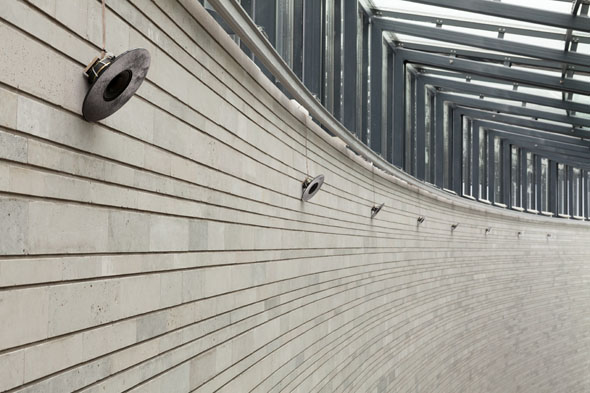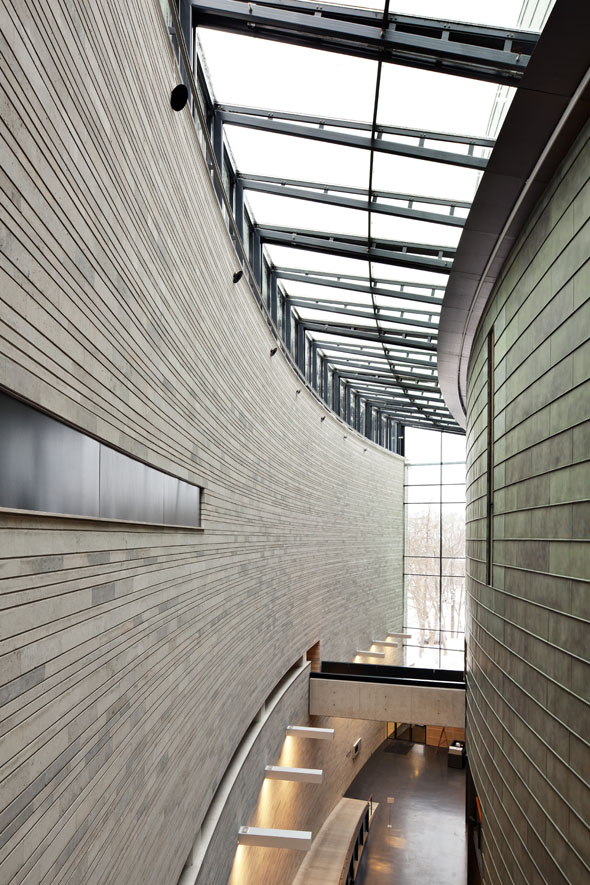K O I R O H I
Sound installation, 2012
Koirohi is a 16-channel sound installation created for the exhibition SPATIUM at the KUMU Art Museum in Tallin, Estonia.
16 loudspeakers play recordings from an active nuclear power plant located Olkiluoto in Finland, very close to Tallin. KOIROHI means wormwood in Estonian like Chernobyl which means wormwood in Ukrainian. With sensitive contact microphones and accelerometers placed directly on turbines, boilers, and thousands of meters of pipes above and below the ground, vibrations from the production of nuclear power can be heard. Since all these elements vibrate at very different rates and through different materials the sounds are rich in overtones, and have an almost dreamy or unearthly quality. Their resonances from the 120 meter massive stone wall transforms the museum into a nuclear cathedral
Catalogue text of Jacob Kirkegaard's contributions for the exhibition SPATIUM. By curator Maria Kjær Themsen:
AION (2006) & KOIROHI (2012)
As a sound artist Jacob Kirkegaard works with the sonic elements of our world that are normally unheard or inaudible to the human ear. It can be sounds from some of the world’s natural phenomena, like a geyser or the sand in a desert, manmade places such as a TV tower or an empty room, or it can be sounds from the inner ear itself. His two works presented at Spatium reveal the sounds of nuclear power.
In the long left ghost city of Chernobyl, Kirkegaard visited four abandoned public spaces; beautiful and lonely rooms, with strong inherent narrative qualities. AION is a combination of video and sound recordings, which gives a poetic and living portrait of a place, where disaster and death is prevailing. The recordings were made in an old church, a gymnasium, a swimming pool and a concert hall, all once filled with people and life. In these rooms he placed sensitive microphones, recorded the sounds and vibrations of the place, and played them back out into the space, while still recording. In this process, different layers of recorded ambient sound made the rooms resonate with their own sounds. What is normally not heard became audible, while the dripping sounds from broken pipes merged with the distant humming of lost times.
AOIN means ‘infinity’ in Greek, and in the context of nuclear power, it is quite literally an infinite period of time that must pass before heavily polluted areas will again be habitable. It is a span of time, which is greater than our limited consciousness can fully grasp. But in AION we can poetically experience a sense of the disaster, when we see a world that suddenly collapsed, and was left in a hurry, and we hear the sounds from a time long gone whispering in our ears.
In the corridor Kirkegaard has placed 16 loudspeakers that play recordings from the nuclear power plant Olkiluoto in Finland, which is still operating. The work is called KOIROHI, which means wormwood in Estonian (like Chernobyl which means wormwood in Ukrainian). With sensitive contact microphones and accelerometers placed directly on turbines, boilers, and thousands of meters of pipes above and below the ground, vibrations from the production of nuclear power can be heard. Since all these elements vibrate at very different rates and through different materials the sounds are rich in overtones, and have an almost dreamy quality. Here a new experiment is also being made; the large-scale project Onkalo is an attempt to create the world's first permanent storage of highly radioactive nuclear waste deep underground in the Finnish bedrock.
AION and KOIROHI function as extensions of one another. While Chernobyl represents the ghostly absence of human presence, but yet still full of remnants of the lives once lived there, Olkiluoto splits its atoms amidst its constant singing overtones, just across the sea.


